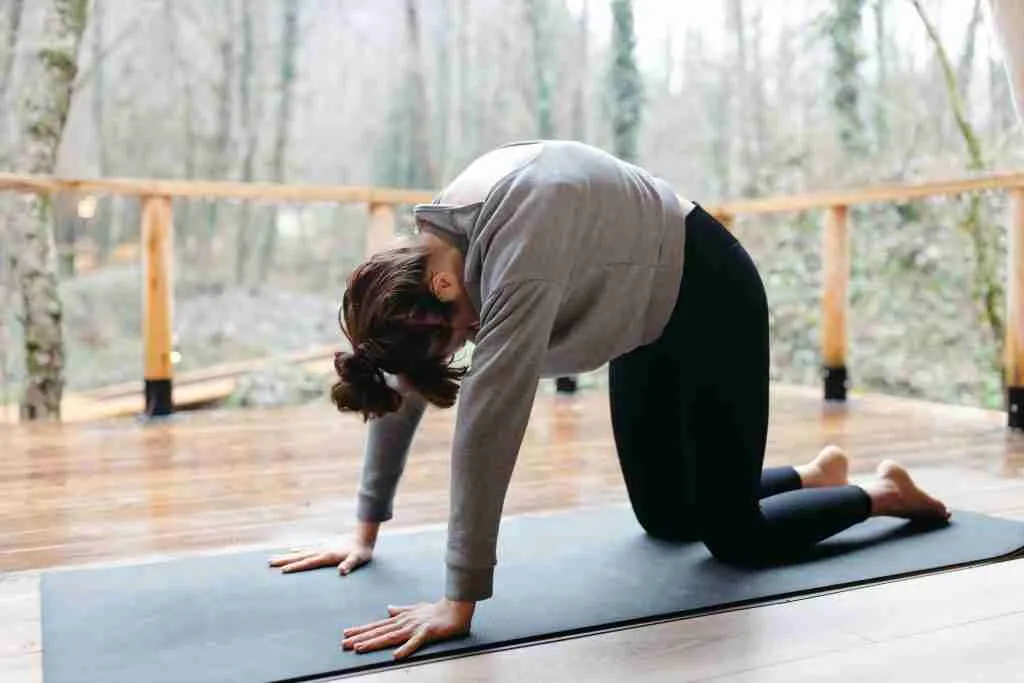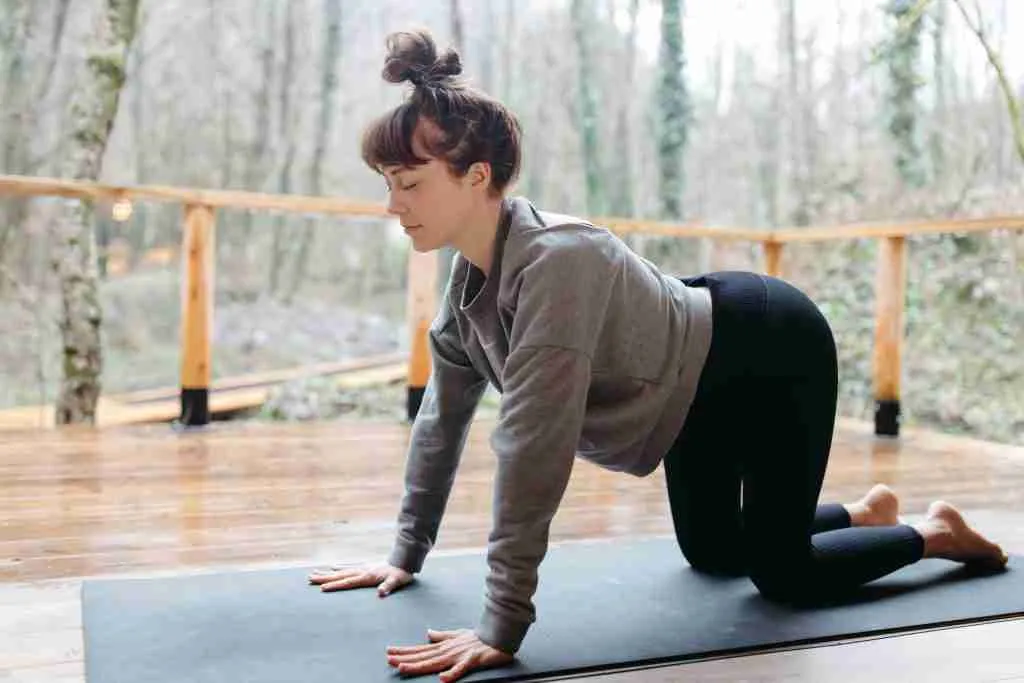Cat-Cow is just the right pose to improve your flexibility, relieve stress, and unleash incredible benefits for your body and mind.
This versatile pose suits yogis of all levels and can easily integrate into your daily routine. In this article, you will learn all about the background, execution, and benefits of the Cat-Cow stretch.
What Is the Cat-Cow Stretch?
Cat-Cow combines a forward bend and a slight backbend in a quadrupedal stance.
The pose combines Marjaryasana (Cat pose) and Bitilasana (Cow pose). The two asanas are connected with a flowing, breath-synchronous movement.
The name refers to a cat’s soft and supple movement, on which the exercise is based. The posture aims to improve the spine’s flexibility, suppleness, and mobility.
It is almost an essential component to warm up in a yoga flow. Cat-Cow is an excellent exercise for more intense poses and mobilizing the spine.
Is Cat-Cow Suitable for Beginners?
The Cat-Cow stretch is one of the most common yoga exercises suitable for beginners. It is one of the more straightforward exercises and can be used universally to improve spinal mobility.
In Which Yoga Classes Is the Pose Practiced?
Due to its varied variations, Cat-Cow can be practiced in any yoga class. It is primarily used in the preparatory phase of a course to build up to more intense postures.
For example, it is part of the following classes:
- Hatha Yoga
- Vinyasa Yoga
- Hormone Yoga
- Power Yoga
What Are the Benefits of Cat-Cow?
The posture improves the spine’s mobility, strengthens the entire back muscles, helps to release tension, and is an effective exercise against back pain.
Energetically it has a harmonizing effect. It also stimulates the thyroid gland and thus can improve metabolism and prevent osteoporosis.
1. Stretches Hips, Abdomen, and Back
The asana releases tension in the upper back and neck. The stretch allows the body to relieve stress or pain in the lower back and sciatica.
The movement also stretches the muscles of the hips, abdomen, and chest.
2. Improves posture and Flexibility
The cat-cow pose increases flexibility and mobility of the neck, shoulders, and entire spine.
3. Improves Balance and Coordination
Some variations of the cat-cow are combined with a balance exercise, for example, by extending an arm and leg diagonally. This way, you playfully strengthen balance and coordination.
4. Strengthens Spine and Neck
The movement activates the tailbone and releases neck and upper back tension. It also improves blood circulation in the spine.
5. Relieves Menstrual Cramps
The asana helps regulate the menstrual cycle if you practice it regularly. Researchers have even proven that the Cat pose during menstruation reduces the severity and duration of period cramps (Rakhshaee 2011).
6. Stimulates Organs and Glands
The asana massages and stimulates organs and glands in the abdominal area, such as the kidneys and adrenal glands.
In addition, the Cat-Cow stretch stimulates the thyroid gland, can improve metabolism, and prevent osteoporosis. For this reason, it is regularly practiced in hormone yoga classes.
7. Relieves Stress and Calms the Mind
Yoga calms the mind, reduces stress, and restores emotional balance.
How to Do the Cat-Cow Stretch
- Starting position: get into the quadruped position. Knees are hip-width open, hands under shoulders, fingers are spread evenly and point forward. The spine is in a neutral starting position. Gaze down. Actively push your hands and knees into the floor and tighten your abdomen.
- Cat pose: Exhale, round your spine with your lower back, and lift your mid back while lowering your tailbone and pulling your chin toward your chest. The gaze goes towards the belly button.
- Cow pose: Inhale, lower the belly towards the floor, arch the back, lift the chest, and at the end, the head. The gaze goes forward or upward.
- Repeat: Practice the exercises alternately and in sync with your breathing.


Common Mistakes
- Be careful not to bend at the wrists and keep the arms extended.
- Pull the shoulders away from the ears.
- Integrate the cervical spine harmoniously into the movement and raise/lower the head only at the end of the action.
Expert Tips to Improve
- Move the spine in a harmonious arc, always starting with the lowest vertebra and ending with the head.
- Try to perceive the movement of each vertebra consciously.
- Pay attention to even breaths and perform the movement synchronously with your breath.
- If you have sensitive wrists, you can warm them up briefly by interlacing your hands, rotating them, and then shaking them out.
- If you have wrist or knee injuries and don’t want to strain them, you can also move in a seated position.
Variations
- Sitting variation: Sit cross-legged and place your hands on your knees. With an exhalation, pull the belly button inward and round the back for the cat pose. Pull the chest forward with the inhale and come into a slight backbend.
- Standing variation: Stand hip-width apart with knees slightly bent. Place your hands on your thighs and round your spine with an exhalation. With inhalation, you do the opposite movement.
- Stretched Tiger: This variation is suitable for strengthening your core and balance. You start in a quadrupedal position. Extend one arm forward and the opposite leg backward. Keep your hips parallel. With an exhalation, bring your elbows and knees together under your torso, rounding your back. Extend your arm and leg again with the inhale and find the length. Repeat the exercise several times and then switch sides.
Modifications
- If you have neck problems, don’t let it fall forward or back too much. Keep your head in a straight line with your torso and look down at the floor or straight ahead.
- Pregnant women or those with back injuries should only perform the cow pose, returning the spine to a neutral position between poses.
- If you have sensitive knees, you can place a folded blanket under your knees.
- Balasana, the child’s pose, is excellent for balancing and complementing Cat-Cow.
Frequently Asked Questions (FAQ)
What is the Cat Cow stretch good for?
Cat-Cow mobilizes the spine, strengthens the entire back muscles, helps relieve tension, and is excellent as a warm-up and preparatory exercise for other yoga poses.
How many times should you do Cat-Cow?
The exercise can be a daily part of various yoga classes and is performed for 5-10 breath cycles.
How long do you hold a cat stretch?
Since Cat-Cow is a dynamic sequence of movements, it is performed in sync with breathing and is usually not held at all or only for one breath.
Do you inhale or exhale during Cat-Cow?
During cat (round back), you exhale; during cow (bent back), you inhale.
Mag. Stephan Lederer, MSc. is an author and blogger from Austria who writes in-depth content about health and nutrition. His book series on Interval Fasting landed #1 on the bestseller list in the German Amazon marketplace in 15 categories.
Stephan is a true man of science, having earned multiple diplomas and master's degrees in various fields. He has made it his mission to bridge the gap between conventional wisdom and scientific knowledge. He precisely reviews the content and sources of this blog for currency and accuracy.
Click on the links above to visit his author and about me pages.

